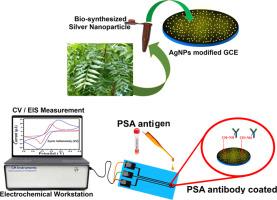Bio-synthesized silver nanoparticle modified glassy carbon electrode as electrochemical biosensor for prostate specific antigen detection
Abstract
Prostate cancer is the second leading cause of death for men after lung cancer. Therefore, early detection of cancer proteins or biomarkers is crucial in assessing the disease's reappearance after treatment. Here, we have reported the glassy carbon electrode (GCE) based electrochemical biosensors fabricated using Carbon-Microelectromechanical Systems (C-MEMS) technology for prostate-specific antigen (PSA) quantification. This report also presents the biosensor improvement by modifying the GCE with silver nanoparticles (AgNPs). Moreover, our investigation extends to bio-synthesized AgNPs that bring together advantageous chemical and physical attributes at a reasonable cost. In addition, AgNPs modified GCE have a more comprehensive anodic potential range [˗0.2 V to +0.3 V] than bare glassy carbon (GC). Electrochemical impedance spectroscopy (EIS) and cyclic voltammetry (CV) measurements were used to examine the electrochemical response of the biosensors. As a result of the use of AgNPs-modified GCE, we have developed a label-free analytical system for prostate cancer detection, which can provide a linear response in the concentration range of 1 pg/ml - 3 µg/ml in a reasonably simple operation. The developed biosensors may be used for the early detection of prostate cancer in clinical analysis due to the excellent sensitivity demonstrated by this electrochemical biosensor.


| 公司名称 | 产品信息 | 采购帮参考价格 |
|---|
 求助内容:
求助内容: 应助结果提醒方式:
应助结果提醒方式:


